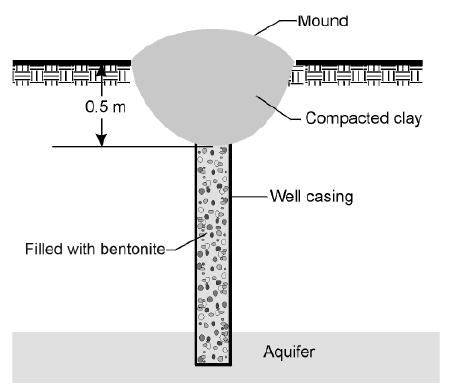| | Introduction | Reclamation steps that should be followed | Temporary suspension requirements | Responsibilities of the operator | For more information
Purpose
- To guide reclamation of groundwater monitoring wells
Audience
- Confined feeding operators with groundwater monitoring wells that are no longer required
- Consultants or contractors conducting well reclamation work
Relevant Legislation
- Agricultural Operation Practices Act
- Water Regulation of the Water Act
Risks Addressed
- Contaminated surface water reaching groundwater through well space
- Groundwater movement and transfer between aquifers
Introduction
Operators of confined feeding operations (CFOs) who are required to reclaim abandoned or active groundwater monitoring wells should contact the nearest Natural Resources Conservation Board (NRCB) field office or Agriculture and Forestry (AF) CFO extension specialist to discuss options for their individual situations. It is recommended that a contractor/consultant conduct the reclamation work.
Reclamation steps that should be followed
| 1. | Flushing – The well or borehole must be thoroughly flushed and cleaned by bailing or purging. |
| 2. | Removal of casing – For proper reclamation, well casings can be pulled or drilled out from the borehole. If it is impracticable to remove the casing it may be left in the ground, provided it is properly sealed. The casing must be cut off at least 0.5 metres below ground level. |
| 3. | Filling – The well or borehole must be progressively backfilled with sealing material from the total depth to within 0.5 metres of the ground surface. The full length of the well or borehole must be filled so that the vertical movement of water within the well or borehole is effectively and permanently prevented.
|
 | Acceptable sealing materials include:
• manufactured high yield bentonite products
• grout
• concrete
Bentonite is a special type of clay that swells when wet to provide an effective impervious seal. It comes in chip (medium or coarse), pellet, tablet or granular forms that are designed to pour into a well or borehole. Bentonite chips are most often used because they are readily available and relatively inexpensive.
The method of placing sealing material into the well or borehole is critical. When bentonite chips are used to seal the well or borehole, they can be poured in from the ground surface. When properly introduced (i.e. are poured slowly) the chips should reach the bottom of the well or borehole before swelling. Care must be taken to prevent bridging, which will result in a partially sealed well.
The appropriate size and the amount of chips required for the depth and diameter of the well or borehole should be determined prior to placement. To determine the amount of bentonite chips required, the total depth and diameter must be identified (see Table 1).
Table 1. Approximate bentonite required for typical well or borehole diameters (from CETCO Drilling Products 2009)
| Hole Diameter (in) | 2 | 4 | 6 |
| Approximate Pounds of Chips per Linear Foot | 1.5 | 6 | 14 |
 |  |  |  |
| Hole Diameter (cm) | 5 | 10 | 15 |
| Approximate Kilograms of Chips per Linear Meter | 2.2 | 9 | 21 |
The depth to the top of the sealing material should be measured frequently to determine if the seal is rising more quickly than expected, which may indicate bridging. Any bridging should be corrected before adding more sealing material.
If the sealing material used is a bentonite slurry, cement, grout, or concrete, special equipment must be used to introduce the sealing material from the bottom of the well or borehole, and to progressively place it upward to the ground surface. Typically only consultants or drilling contractors have the expertise and equipment to properly introduce sealing material in this manner. |
| 4. | Surface completion – From a depth of 0.5 metres to the ground surface, the reclaimed well must be backfilled with material appropriate for the intended use of the land (Figure 1). |
| 5. | Recordkeeping – All monitoring wells being reclaimed should be recorded and documented (see accompanying worksheet).
Records should include:
- name and land location of the CFO
- type of facility
- location of the well or borehole
- ID of the well or borehole
- total depth and diameter of the well or borehole
- date of reclamation
- type and amount of sealing material used
- method used to reclaim the well or borehole
- name of the person(s) responsible for reclamation of the well or borehole
|

Figure 1. Reclaimed groundwater monitoring well
Temporary suspension requirements
If a monitoring well is not being used, but should be maintained for future use, the following steps should be taken.
- Thoroughly flush the well and clean out all foreign materials.
- Securely cap the well with a sealing device that prevents the entry of any substance into the well that could adversely affect the water quality in the well.
- Mound the ground around the well to reduce the potential of surface water inflow.
Responsibilities of the operator
The operator must ensure that the monitoring well is kept in good condition and that the sealing device is maintained and in place until the well is put back into service or is properly reclaimed.
Monitoring Well Reclamation Worksheet (PDF Supplement to Adgex 096-50, 420 KB)
For more information
Contact your nearest NRCB field office or an AF Agri-Environmental Extension Specialist (dial 310-0000 to be connected toll free)
Alberta Agriculture and Forestry
www.agriculture.alberta.ca/aopa
Ag Info Centre 310 FARM (3276)
Publications (780) 427-0391
Natural Resources Conservation Board
www.nrcb.ca
Fairview - closed, please contact Morinville.
Morinville (780) 939-1212
Red Deer (403) 340-5241
Lethbridge (403) 381-5166
This guideline was developed by the Technical Advisory Group, a partnership between Agriculture and Forestry, the Natural Resources Conservation Board and the agricultural industry.
Source: Agdex 096-50. January 2018. |
|